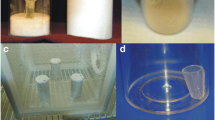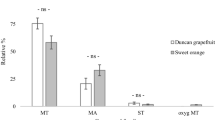Abstract
Chemical cues that elicit orientation by the Asian citrus psyllid, Diaphorina citri Kuwayama (Hemiptera: Liviidae), are of interest because it is the primary vector of the causal pathogen of citrus greening disease. Non-pesticidal control methods for D. citri remain a high priority for the citrus industry. While searching for semiochemicals that may be involved in orientation to host plants, we previously identified a blend of formic and acetic acids that stimulated substrate probing by D. citri. Here, we applied geometric mixture designs and response surface modeling to identify and optimize a 3-component blend that further increased the number of salivary sheaths produced by D. citri on a wax substrate containing a 3.5:1.6:1 blend of formic acid, acetic acid, and p-cymene, respectively. No evidence was found for remote orientation by D. citri adults through olfaction to the phagostimulant blends. Increased probing in response to the presence of phagostimulants in the wax matrix occurred after contact with the substrate. Yellow wax beads always attracted more D. citri adults and received more probes compared with white wax beads. Yellow beads containing the 3-component blend of phagostimulants were probed by D. citri 2 to 3 times more often compared with yellow beads alone. The phagostimulant effect also was tested by covering wax beads containing the 3-component blend with a plastic film to minimize olfaction or contact chemoreception by antennation. The plastic film did not affect the probing response, thus suggesting that chemosensation was associated with mouthparts and not olfactory receptors. Salivary sheaths produced in wax beads containing the phagostimulant blend were 4.5 times longer than sheaths produced in beads without tastants. This phenomenon might be used to improve a trap, design an attract-and-kill product, or enhance other means of managing D. citri and citrus greening disease.






Similar content being viewed by others
References
Aksenov AA, Martini X, Zhao W, Stelinski LL, Davis CE (2014) Synthetic blends of volatile, phytopathogen-induced odorants can be used to manipulate vector behavior. Frontiers Ecol Evol 2(78):1–9
Anderson MJ, Whitcomb PJ (2005) RSM simplified-optimizing processes using response surface methods for design of experiments. Productivity Inc., New York
Box GEP, Cox DR (1964) An analysis of transformations (with discussion). J R Stat Soc, Series B 26:211–246
Cornell JA (2002) Experiments with mixtures, 3rd edn. Wiley & Sons, New York
Coutinho-Abreu IV, Forster L, Guda T, Ray A (2014a) Odorants for surveillance and control of the Asian citrus psyllid (Diaphorina citri). PLoS One 9:e109236
Coutinho-Abreu IV, Mcinally S, Forster L, Luck R, Ray A (2014b) Odor coding in a disease-transmitting herbivorous insect, the Asian citrus psyllid. Chem Senses 39:539–549
Cox DR (1971) A note on polynomial response functions for mixtures. Biometrika 58:155–159
Fares S, Park JH, Gentner DR, Weber R, Ormeño E, Karlik J, Goldstein AH (2012) Seasonal cycles of biogenic volatile organic compound fluxes and concentrations in a California citrus orchard. Atmos Chem Phys 12:9865–9880
Garzo E, Bonani JP, Lopes JRS, Fereres A (2012) Morphological description of the mouthparts of the Asian citrus psyllid, Diaphorina citri Kuwayama (Hemiptera: Psyllidae). Arthropod Struct Dev 41:79–86
George J, Robbins PS, Alessandro RT, Stelinski LL, Lapointe SL (2016) Degradation products of plant volatiles elicit olfactory and behavioral responses from an insect vector of a major plant pathogen. Chem Senses 41:325–338
Godfrey KE, Galindo C, Patt JM, Luque-Williams M (2013) Evaluation of color and scent attractants used to trap and detect Asian citrus psyllid (Hemiptera: Liviidae) in urban environments. Fla Entomol 96:1406–1416
Hall DG, Hentz MG, Patt JM (2015) Behavioral assay on Asian citrus psyllid attraction to orange jasmine. J Insect Behav 28:555–568
Kennedy JS, Stroyan HLG (1959) Biology of aphids. Annu Rev Entomol 4:139–160
Kreuzwieser J, Harren FJM, Laarhoven LJJ, Boamfa I, Lintel-Hekkert ST, Scheerer U, Hüglin C, Rennenberg H (2001) Acetaldehyde emission by the leaves of trees– correlation with physiological and environmental parameters. Physiologia Plantarum 113:41–49
Lapointe SL, Evens TJ, Niedz RP (2008) Insect diets as mixtures: optimization for a polyphagous weevil. J Insect Physiol 54:1157–1167
Li W, Li D, Twieg E, Hartung JS, Levy L (2008) Optimized quantification of unculturable Candidatus Liberibacter spp. in host plants using real-time PCR. Plant Disease 92:854–861
Mann RS, Ali JG, Hermann SL, Tiwari S, Pelz-Stelinski KS, Alborn HT, Stelinski LL (2012) Induced release of a plant-defense volatile 'deceptively' attacks insect vectors to plants infected with a bacterial pathogen. PLoS Pathog 8:e1002610
Martini X, Pelz-Stelinski KS, Stelinski LL (2014) Plant pathogen-inducedvolatiles attract parasitoids to increase parasitism of an insect vector. Front Ecol Evol 2:8
NASS (2016) Citrus forecast (January 2016). US. Dept. Agric., Nat. Agric. Stat. Service;www.nass.usda.gov/Statistics_by_State/Florida/Publications/Citrus/cit/2015-16/cit0116.pdf (referenced 2/1/16)
Nation JL (2002) Insect physiology and biochemistry. CRC Press, Boca Raton
Oikawa PY, Lerdau MT (2013) Catabolism of volatile organic compounds influences plant survival. Trends Plant Sci 18:695–703
Patt JM, Sétamou M (2010) Responses of the Asian citrus psyllid to volatiles emitted by the flushing shoots of its rutaceous host plants. Environ Entomol 39:618–624
Patt JM, Woods D, Dimitratos S, Meikle W, Stockton D, Lapointe S, Mafra-Neto A (2013) Novel synthetic ligands enhance the behavioral responses of Asian citrus psyllid to naturally occurring host-plant volatiles. In: Beck J et al. (eds), Pest management with natural products, ACS Symp Ser, pp111–124
Piepel GF (1982) Measuring component effects in constrained mixture experiments. Technometrics 25:97–101
Powell G, Tosh CR, Hardie J (2006) Host plant selection by aphids: behavioral, evolutionary, and applied perspectives. Annu Rev Entomol 51:309–330
Rohde B, Paris TM, Heatherington EM, Hall DG, Mankin RW (2013) Responses of Diaphorina citri (Hemiptera: Psyllidae) to conspecific vibrational signals and synthetic mimics. Ann Entomol Soc Am 106:392–393
Sétamou M, Sanchez A, Saldana RR, Patt JM, Summy R (2014) Visual responses of adult Asian citrus psyllid (Hemiptera: Liviidae) to colored sticky traps on citrus trees. J Insect Behav 27:540–553
Tena A, Hoddle CD, Hoddle MS (2013) Competition between honeydew producers in an ant–hemipteran interaction may enhance biological control of an invasive pest. Bull Entomol Res 103:714–723
Tjallingii WF (1978) Mechanoreceptors of the aphid labium. Entomol Exp Appl 24:731–737
Weisberg S (1985) Applied linear regression, 2nd edn. Wiley & Sons, New York
Wenninger EJ, Stelinski LL, Hall DG (2009a) Roles of olfactory cues, visual cues, and mating status in orientation of Diaphorina citri Kuwayama (Hemiptera: Psyllidae) to 4 different host plants. Environ Entomol 38:225–234
Wenninger EJ, Hall DG, Mankin RW (2009b) Vibrational communication between the sexes in Diaphorina citri (Hemiptera: Psyllidae). Ann Entomol Soc Am 102:547–555
Wensler RJ (1977) The fine structure of distal receptors on the labium of the aphid, Brevicoryne brassicae L. (Homoptera). Implications for current theories of sensory transduction. Cell Tissue Res 181:409–422
Wilson EO (1971) The insect societies. Belknap Press, Harvard University, Cambridge, MA (USA) and London, England
Acknowledgments
We thank Larry Markle, Evan Koester, Bill Sauveur, and Matt Hentz for technical assistance and Anna Sara Hill (all USDA-ARS, Ft. Pierce, FL) for insect rearing. The manuscript was improved by comments from Joseph Patt (USDA-ARS, Ft. Pierce, FL). Significant funding was provided by the Citrus Research and Development Foundation. ISCA Technologies Inc., Riverside, CA graciously provided SPLAT™ products used in these studies. USDA is an equal opportunity provider and employer. Mention of a trademark or proprietary product does not constitute a guarantee or warranty of the product by the United States Department of Agriculture and does not imply its approval to the exclusion of other products that may also be suitable.
Author information
Authors and Affiliations
Corresponding author
Rights and permissions
About this article
Cite this article
Lapointe, S.L., Hall, D.G. & George, J. A Phagostimulant Blend for the Asian Citrus Psyllid. J Chem Ecol 42, 941–951 (2016). https://doi.org/10.1007/s10886-016-0745-4
Received:
Revised:
Accepted:
Published:
Issue Date:
DOI: https://doi.org/10.1007/s10886-016-0745-4




